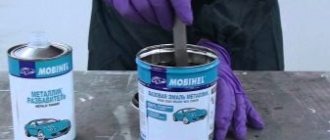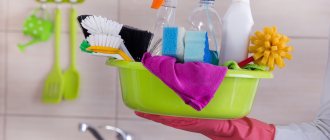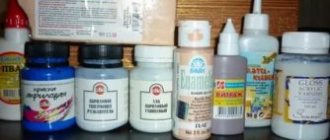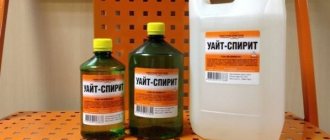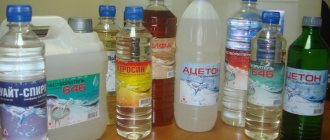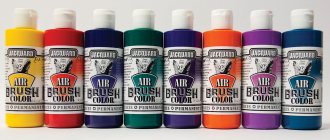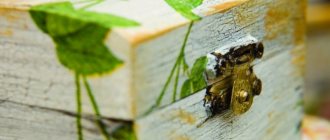Carrying out painting work involves not only preparing paint and varnish, but also preparing the correct composition for this procedure.
The overall result depends on the physical properties of the painting material.
If the work will be carried out using a spray gun, then the composition should be liquid, this way it will be possible to avoid smudges. But when holding brushes in your hands, you should use viscous paint. As a rule, all manufacturers indicate how to dilute their product, but sometimes the instructions can be an excellent advertising event that promotes a related product of the same brand, and it can be expensive.
To minimize costs and obtain high-quality components for painting a car, you should know the criteria for choosing paint, solvent, their interaction conditions, and much more.
When carrying out high-quality grinding work on the body, some cracks still remain on it. To fill all micro cracks, it is worth applying less thick paint.
Otherwise, minor deformations may appear on the painted surface of the car.
It is also not worth diluting the paint too much, because this is fraught with the appearance of shagreen, and the surface will take a long time to dry and worse, and who knows what may happen during this time.
This result directly depends on the paint, but the varnish plays an equally important role in the result; it is responsible for the gloss and strength of the coating that was previously applied.
But still, the solvent is added to the paint so that it adheres more easily to the surface; the only question remains in proportion, which depends on all the conditions where painting is carried out, taking into account technologies, volumes and many other points.
The quality of the applied coating determines the protection of the body from corrosion and other physical damage.
Solvents are divided depending on the temperature and time it takes for the paint to dry, but first of all you need to decide on the paint, how to choose it?
Which solvent to choose for car paint
Car painting jobs require attention and knowledge. To make a car look beautiful, it is necessary not only to carefully prepare the surface of the car body, but also to choose a high-quality paint coating. Moreover, the material must be prepared correctly. To achieve a better result, a special car paint solvent is added to it.
Types and features of the choice of solvents and thinners for automotive paints
All existing types of solvents can be divided into several groups, each of which differs from each other in the rate of evaporation. The solvent that will be added to the car paint is selected depending on climatic conditions. There are 3 types of funds:
- universal – used under any conditions;
- slow – can be used in places with elevated (positive) ambient temperatures;
- fast - used only at sub-zero temperatures.
Paint diluted with a solvent is applied using a spray gun. In order for the coating to be smooth and uniform, the degree of thickness of the product should also be selected so that the equipment can work effectively.
Important! When working with paints, it is necessary to take into account the outside air temperature. This is the main parameter on which the quality of the future coating depends.
Manufacturers of paints and varnishes produce several types of special thinners, which differ significantly from solvents in their effectiveness. And this difference is significant. The diluent is simply added to the product, thereby diluting it to the required concentration.
Important nuances when diluting acrylic compounds
The scope of use of acrylic paints makes it necessary to adhere to a number of rules:
- To quickly and most effectively mix the composition, you should use a construction mixer.
- For dilution, only purified and settled water is used. There should be no impurities in the water.
- To effectively remove the composition from a surface not used for painting, use a damp cloth.
- When working with acrylic composition, you should follow the attached instructions.
- For furniture restoration and using paint-by-number kits, the dilution ratio with water will be 1:1.
When using a chemical solvent, the connection is carried out gradually. A little thinner is added to the paint, after which everything is thoroughly mixed. The chemical is added in small portions, while the mixing process does not stop. Additives are used until the desired result is achieved.
Several useful videos on the topic:
Tips and tricks for proper paint dilution
There are a huge number of paints and varnishes, but only some of their representatives are used to paint a car:
All of them differ from each other in performance characteristics, but at the same time they are effectively used by car owners. For a 100% high-quality result, these products are diluted with solvents. What solvent should you use to dilute car paint?
Acrylic paints
This is a two-component liquid, which contains a thinner and a hardener. The desired color is achieved by applying a certain number of layers of material.
- does not fade in the sun, ages slowly;
- easy to apply and does not require varnishing;
- dries quickly;
- can be used at high temperatures;
- easy to polish.
For acrylic paints, a specialized automotive solvent is used, which is more expensive than conventional organic solvents (646, 647), but it is worth it. If such a product could not be found, then you can use its analogue - solvent 651 or P 12.
Alkyd paints
Such products are rarely used for painting car bodies, only because they require a more careful approach. The resulting surface should be varnished and polished, but the finished products are distinguished by high performance characteristics and good appearance. The coating prevents the formation of corrosion and performs well in adverse conditions.
For dissolution, white spirit, gasoline, solvent, turpentine and its mixtures are used. There is a universal solvent P 4, but it is better to choose according to the product labeling.
Nitro enamels
They have a mirror effect, for which they have received wide appreciation from car enthusiasts. The body, painted with nitro enamel, differs from other cars in its gloss and metallic sheen. The only significant drawback is toxic fumes during painting work, which are harmful to human health.
Before application, the body surface must be perfectly cleaned and prepared for painting. Nitroenamel dries quickly and lasts quite a long time. It is diluted with organic products, for example, transparent 646.
Advice. This solvent is highly flammable and belongs to the category of aggressive solvents, so it must be handled with extreme caution. To play it safe, you can use the universal product P 4.
Water-based paints
This type of paint is considered the most suitable for painting a car, although it requires expensive equipment to achieve maximum effect. Such products are environmentally friendly and have a number of advantages:
- the surface does not need to be thoroughly prepared;
- there is no swelling effect;
- high adhesion of the material;
- perfect result.
The only negative is the long drying time. Water-based paints are dissolved with plain water or alcohol.
Is it possible to dilute acrylic ceiling paint with water? Advantages of acrylic paints
The most popular and versatile paints for ceilings are acrylic-based paints. Acrylic paints have many advantages, which is why they occupy a leading position in the market among other substances. Let's look at them in more detail.
- Acrylic paint is stain-resistant and elastic, which means it can cover even the smallest cracks - up to 0.5 millimeters. For this purpose, it is customary to apply paint in several layers.
- This is one of the most resistant substances to abrasion and ultraviolet radiation, and therefore does not lose its original color over time.
- Acrylic compounds are not afraid of moisture, so a ceiling painted with acrylic paint is easy to wash and remove dirt from it. Also in this regard, it can be used in rooms with increased humidity, that is, in bathrooms and other damp rooms.
- Acrylic paint is resistant to friction, can easily withstand high temperatures, and also has a fireproof effect, so it can be used in the kitchen.
- Since acrylic paint belongs to the water-based group, it does not have an unpleasant pungent odor, which is inherent in all paint compositions based on organic solvents.
- Acrylic paints are quite easy to apply and dry very quickly, but you need to remember that acrylic darkens after drying.
- The process of painting the surface with acrylic paint will not take much time from the owners and will take a lot of effort.
- Acrylic paint is cost-effective and has a fairly reasonable price. The price of acrylic paint for the ceiling ranges from 200 to 800 rubles.
- As for the color palette, there will be no unsatisfied consumers, because the number of shades of acrylic paint can please the most sophisticated buyers.
Features of metallic paint dilution
Metallic is considered a complex paintwork and requires precise application technology. The product is widely used for painting vehicles (cars and motorcycles). The surface has a metallic reflective sheen. This effect is explained by the presence of special aluminum powder in the material. The finished coating is not affected by corrosion, and the result will please the eye for a long time. However, mechanical stress and disruption of the integrity of the coating will ultimately lead to its destruction. The paint does not fade under the influence of ultraviolet rays of the sun.
The quality of the coating depends on the degree of viscosity of the material, so the solvent for such paint is carefully selected. A product that is too thick can harm the result because it will not be able to completely fill the rough surface of the car body. Modern metallic paints and varnishes are diluted directly by the manufacturer and are ready for application. The cost of such materials is much higher than others, however, the quality of the coating will amaze with its splendor and beauty.
Features of metallic painting
Metallic paint is a one-component composition that does not require a hardener. Its peculiarity is the presence of metal particles: the color manifests itself depending on the depth of their occurrence.
Do-it-yourself painting is a complex process that requires accuracy and adherence to technology, since even minor deviations from it are immediately noticeable. A common problem is bullseye: round spots that can appear even after all stages of painting.
To eliminate this defect, wet and dry grinding is carried out, and then cosmetic painting.
How to thin car paint?
Different types of car paint have different compositions, which determine their chemical and physical properties. Many types of car enamel contain a certain amount of solvent, so they do not require preliminary preparation before use.
But it is worth considering that during long-term storage all paints thicken, lose color and dry out, which can lead to problems during their subsequent use. Viscous paint spreads less well over the surface being painted, which leads to the appearance of sagging and other defects.
In order to avoid having to repaint the car body after painting, it is recommended to immediately give the car paint the required consistency. How to dilute it? Today we will look at this issue in more detail.
Types and composition of enamel
Any industrial automotive paint consists of the following components:
- Binder. It ensures fixation of car enamel on a metal or plastic part or element to be painted, due to which the car body acquires a uniform, smooth, glossy surface;
- Coloring pigment . The powdery component of the paint, which is responsible for the resulting shade and its saturation;
- Solvent . Gives the paint and varnish material a certain degree of viscosity, ensuring uniform and highest quality spraying.
After applying auto enamel to a part or body structure element, the solvent gradually evaporates, leaving a durable and strong composition of color pigment and binder.
The long service life and impeccable performance of the selected automotive paint are determined by the degree of its hardness and elasticity. Depending on the chemical composition, there are several types of auto enamel, which is important to consider before choosing a solvent:
- Alkyd . The main component of the enamel is an oil resin, thanks to which rapid polymerization of paintwork materials on the surface of the body is achieved under conditions of normal humidity and air temperature. Alkyd paint is not intended for complete vehicle painting, since it requires multiple applications of varnish and the need for subsequent polishing. The rapid drying process of auto enamel can lead to the appearance of numerous defects;
- Melamine-alkyd. The paint polymerizes at high temperatures - from 110 to 140 degrees, and is usually used in factory conditions. Auto enamel creates a durable, reliable coating on the surface of the body that is resistant to adverse external factors;
- Acrylic. The composition contains only two components - a color pigment and a hardener; it has gained wide popularity among car enthusiasts due to the absence of the need for subsequent application of varnish. After painting with acrylic paint, the surface acquires a rich shade and glossy shine;
- Nitro . Used when performing local repair work, the main advantage of auto enamel is the rapid polymerization process (at ambient temperatures above 20 degrees it takes half an hour).
According to the degree of concentration, paint is divided into three groups - high-filled, medium-filled and low-filled. When choosing the type and amount of solvent used for diluting car enamel, this parameter must be taken into account; in this case, when painting the body, the paint will not dry out too quickly, which can lead to the appearance of a large number of defects.
Note! Low-fill car paint should not be diluted with large amounts of solvent.
In what cases and why is it necessary to thin the paint?
In any paint, regardless of its composition, there are main binding components, due to which the layer of applied paint and varnish material “adheses” to the base (in our case, the surface of the walls).
After opening the paint container, you may need to dilute the paint to paint the walls. The main reasons are:
- paint too thick;
- difficult to apply;
- the terms or storage conditions of the paint and varnish material have been violated.
In any case, the decision on the need and advisability of adding water to the paint is made based on its initial thickness after opening the can.
The main task at this stage is to bring the composition to a consistency suitable for application to the surface of the walls using the chosen method (brush, roller, spray gun).
IMPORTANT! In order to obtain a durable coating that meets the declared properties and characteristics, it is fundamentally important to follow the manufacturer’s recommended dilution proportions.
As a rule, the paint is stirred until a homogeneous mass of the desired consistency is obtained by gradually adding water. It is better to mix the paint with a wooden brush, stick or mixer.
Experts advise diluting the paint material if:
- difficult to apply to the surface;
- lays down in an uneven or too thick layer;
- does not pass well through the nozzle of a spray gun or spray gun.
If you plan to work manually (using a brush or roller), then the paint should be sufficiently viscous (an excessively liquid composition will splash or drain from the brush, leaving unsightly stains and preventing uniform application).
If you are going to paint using a spray gun or spray gun, then the composition definitely needs to be diluted to a liquid state, otherwise the paint will pass through the device poorly, preventing you from achieving high quality and uniform paint application.
It is possible that the container with paint was stored in incorrect conditions or after it was first opened, it stood for a long time, while the lid was no longer closed as tightly as when it was originally packaged. In such a situation, the paint begins to dry out and the situation can be corrected only if the composition has not had time to completely harden.
How to dilute car enamels of different composition?
Using thick paint when painting a car leads to an unaesthetic result - various defects, sagging and shagreen. Applying viscous auto enamel using a spray gun results in a lack of mirror shine and an attractive appearance of the body.
The paint must be diluted immediately before performing the procedure for painting the surface of the vehicle body. Compliance with the proportions of mixing the compositions and the correct choice of solvent will ensure high-quality, problem-free application of auto enamel and a quick drying process.
Thinning the paint allows you to achieve the ideal viscosity of the paint composition, sufficient to cover the entire area of the car body. The wrong choice of solvent can lead to problems during the painting process - poor adhesion to metal surfaces, delamination, the formation of thick lumps and “flakes”.
Note! Before choosing how to dilute the paint, you should carefully study the instructions on the car enamel packaging. Many paint and varnish manufacturers provide recommendations on the use of their products and the choice of solvent.
Different solvents are suitable for certain types of automotive paint:
- White Spirit. It is used mainly for degreasing and cleaning the body surface to be painted before applying enamel. Suitable for slate or rubber bitumen mastic, not recommended for diluting acrylic car enamel;
- №646. An aggressive solvent that not only reduces the viscosity of paintwork materials, but also leads to a change in its chemical composition. It should be used with caution in combination with acrylic paint and some types of primers;
- №647. The solvent is used with car varnishes and nitro paints and has an aggressive effect;
- Multicomponent composition R-4. Contains acetone or toluene, used to dilute alkyd enamels;
- Toluene and xylene are intended for diluting paint containing chlorinated polymer.
Note! When choosing a suitable solvent, it is worth considering the degree of polarity of the paint material. If liquid hydrocarbons are used in the manufacture of enamel, kerosene or white spirit are suitable for diluting it, the presence of hydroxyl group molecules indicates the polarity of the auto enamel, for which alcohols and ketones are suitable for diluting.
Acrylic car enamels contain a certain amount of water. Reducing their viscosity before use requires the addition of a hardener followed by the addition of a solvent. Economical and budget dilution options are thinners such as No. 651 and R-12.
For alkyd enamel, pure toluene or xylene, as well as multicomponent R-4, are suitable. The use of nitro paint to give a car body a metallic shining effect requires a competent choice of thinner; usually paint manufacturers indicate the recommended composition in the instructions on the packaging (for example, No. 646).
When choosing a paint solvent, in addition to its type and polarity, it is worth considering the temperature dependence. Some thinners are positioned as universal, others are intended for use at a specific ambient temperature (negative or positive).
When diluting paint, it is worth considering the following recommendations:
- When painting at normal temperatures (15-20 degrees), the enamel must be dissolved by 3-5%;
- At low and sub-zero temperatures, the solvent should be added in larger quantities - at least 5-10%.
Peculiarities
An important feature of acrylic is its naturalness; the environment does not suffer from the use of an automotive composition. There are no fumes or strong odor from the paint. The advantage of acrylic is the variety of shades; it is easy to obtain any color using special pigments in the appropriate dosage.
Due to its water base, the substance is resistant to fire. The listed qualities contribute to the use of acrylic in residential premises and small spaces. Water evaporates quickly, causing the material to harden faster than its analogues. An important advantage of the composition is that acrylic can be diluted even after drying, so the substance will return to its original form. You just need to know how to dilute acrylic paint and the recommended dilution rates.
Acrylic auto enamel Mobihel
How to dilute car paint correctly
Painting a car yourself is much more profitable than hiring a professional. You will need to understand all the main points, prepare the necessary substances and become familiar with the intricacies. You will have to prepare the composition correctly, since the result depends on its properties. If you want to use a spray gun, a liquid substance will do. This way, it will be possible to avoid smudges that will negatively affect the appearance of the car. You'll have to figure out how to quickly dilute car paint to get a good result.
How to breed
The dilution method is much simpler than enamels, but depends on the method of application. If the painter paints the surface with a spray gun, the liquid becomes more diluted.
There are many solvents available, but you should choose ones that are suitable for metal surfaces. They are purchased at construction or automotive stores. If you plan to use water, it must be distilled and free of additives, since acrylic is somewhat more demanding than enamels. When in doubt about consistencies or types of solvents, it is recommended to do trial mixing in small batches.
Today, several basic proportions and methods have been developed for diluting car paint:
- 1/1. Used for initial, coarse layers due to the low fat content and easier application with a brush;
- 1/2. More often used for a secondary layer, the brush is better saturated with liquid and creates thin, uniform layers;
- 1/5. It has increased adhesion, the liquid penetrates into small pores, cracks and other irregularities. Relevant for use on textured surfaces;
- 1/15. It is used for specific tasks - creating a gradient or special decor with different saturation of the painted surface. The result is a mixture in which the paint is used only to give a soft, unnoticeable shade. With repeated application, it is possible to create an attractive look with a transition from weak to pronounced color.
Solvent for acrylic paints X-20A
All paints are sold in the form of a thick mixture, so the question of how to dilute paint for a spray gun is obvious and justified. If you want to achieve a uniform layer using a sprayer, it is better to use liquid options - from 1/2 to 1/5.
Rules for choosing paint for painting a car
Enamel can be low-filled, filled to the middle and highly filled. In the latter case, the designation will be VHS. Low-fill ones are signed as LS.
Fullness is a property that characterizes the volatility and viscosity of a substance. You need to pay attention to this criterion in order to understand how much solvent the manufacturer added. Before applying a specific enamel, you should carefully study the instructions.
A solvent is selected separately, which directly affects paint consumption. It can be non-polar and polar. To prevent unpleasant situations, you should purchase products from the same brand, otherwise incompatibility may occur.
When choosing a solvent, you need to focus on the properties of each of the available options:
- P-4. Suitable for dyes where chlorinated polymers are present.
- No. 646. It is considered aggressive and makes significant changes to the composition of the paint.
- No. 647. Also classified as aggressive. It is important to use with caution and follow safety precautions. Suitable for diluting nitro varnish and natroenamel.
- No. 650. It has a soft effect and is compatible with most paints and varnishes.
When painting for the first time, it is recommended to consult a specialist in the store. He will help you choose the right products that will be useful in the process.
Decorative coating and its components
The paint is easy to apply on most surfaces, providing adhesion and sufficient durability. The problem is often the inappropriate consistency of the paint product. Thick paint creates an uneven layer; in some places the saturation is excessive, while in others the original color of the body is visible. The easiest way to solve the problem is to dilute the substance. Having decided what you can use to dilute acrylic paints and take a readily available liquid for dilution, it will not be difficult to create a high-quality coating.
Acrylic paints are easy to apply on most surfaces
The paint always contains 3 main components:
- Water.
- Pigment of the corresponding color.
- Connecting substances.
The most important component is an emulsion made of polymer materials, containing acrylic. High technical and performance qualities and ease of application allowed the paint to be used in many areas. Advantages of the composition:
- suitable for various facade works;
- helps in creating the interior;
- colors various materials;
- increased resistance to ultraviolet rays, this allows the product to be used outdoors;
- durability, the material does not fade, is resistant to peeling, destruction and mechanical damage;
- affordable price. Today, acrylic is classified as a low price category; it is always preferred to save money, although its characteristics provide decent quality;
- Application does not require professional skills; a person can do the coloring on his own.
Paint application does not require professional skills
Thinning is an important procedure to ensure that the car is painted evenly and with high quality. In some cases, the addition of liquid is optional, but in some situations it cannot be avoided.
Information on how to dilute paint for spray guns and other painting methods is applied to the container, but specialists are additionally based on current tasks. For the rough layer, a thick solution is often used, and the final coloring is performed with a thinner substance. Everything here is individual, but there are some norms that are not recommended to go beyond.
How to thin paint for a spray gun
The speed at which paint spreads and dries largely depends on the ambient temperature. Often, product manufacturers advise using a thinner only at a specific temperature.
Auto enamel is sold in liquid form. Immediately after opening, you cannot proceed to application, as preparatory measures will be required. It is necessary to pour the solvent, taking into account the composition of the coloring product. Proportions are determined individually. It is best to choose an option that can be used at low temperatures. If it is more than 25 degrees outside, then you will have to look for a solvent with slow evaporation.
When the paint is ready, you will have to filter it. You can use a standard women's stocking. Next, you can move on to the procedure itself to transform the car.
How much paint do you need to paint a car?
The amount of materials varies depending on various factors. It is impossible to say for sure how much solvent and paint will be needed to purchase. The answer is influenced by the type of surface and dimensions, brand of goods, desired shade. Sometimes the composition has to be applied 2-3 times to achieve the desired result, and this should also be taken into account.
You will need to clarify the type of primer, shade and quality. The spray gun also affects the painting process. For two-component enamel, you will need to use 100 ml of hardener and 500 ml of solvent per 1 liter of paint. The easiest way to measure is to use a viscometer. If it is missing, you can see if the paint is flowing or dripping. It is the second option that is considered preferable. With the right approach to the matter, you will be able to paint your car and avoid the occurrence of various defects due to your own mistakes.
How to thin car paint? Some useful tips
There is an opinion that thinking about how to dilute car paint is an absolutely unnecessary point.
They say that it is already fully prepared for further use. Some of the varieties of automotive enamels, however, already contain a certain amount of solvent. However, it is worth remembering that during storage (and the paint did not reach you immediately from the factory), all such materials thicken. It’s not for nothing that they often come with thinners: it’s wiser to dilute the composition right before use, without guessing how much solvent has evaporated since the enamel was packaged in a jar.
Content
However, even if a thinner is not included, the packaging must indicate which one is suitable for this particular paint and its recommended amount. Don’t neglect these instructions: there are many manufacturers, car enamels have different compositions, and if you don’t want to ruin the body of your car or spend money on repainting it, you should read what the manufacturers wrote on the can.
How to dilute car paint and how much to pour such liquid also very much depends on the ambient temperature. So before buying a solvent, it is worth assessing all the conditions in which you are going to paint.
Why breed?
As already mentioned, over time any paint thickens, even if it is hermetically sealed. Paint that is too viscous will spread very slowly over the surface of the body. As a result, it will harden before it has time to cover the area allotted to it. In addition to unnecessary consumption of substances, this phenomenon also threatens with unsightly sagging on the body. However, when diluting paint, you also need to know when to stop. Paint that is too liquid will simply flow off the body without having time to form a layer of sufficient thickness.
And finally, if you made a mistake with the solvent and took the wrong one, car enamel will behave completely unpredictably: it may stop setting altogether, it may delaminate, or it may form flakes or clots. So the first, main and immutable rule of dilution: carefully read the manufacturer’s recommendations!
Temperature dependence:
Usually the instructions suggest several types of solvents. To choose the right one, you need to know at what temperature each one is used. Some thinners are positioned by the manufacturer as universal, suitable for any temperature
Paint polarity:
It is indicated on the same bank. And if there is no list of suitable solvents there, you need to focus on it.
Enamel is based on polar substances. Solvents must be based on compounds with a hydroxy group: alcohols, ketones, etc.
Non-polar paints made from liquid carbons. Kerosene, white spirit and similar substances are suitable as a diluent.
Solvent and its use
The solvent is sold in bottles and is a clear, colorless liquid with a specific aroma. Most companies simultaneously sell acrylic-based paints and special solvents. Their use is justified to impart additional decorative properties to the coating. Mobihel, Duxone, Body, Kartex, etc. have a similar approach.
Solvent for acrylic paints Bulmat
Using a special thinner, it is possible to achieve:
- special coating texture;
- glossy effect;
- matte appearance.
Metallic painting is popular in cars; the required solvent is available in most stores. Sold in jars, you can select them in a store or on a thematic forum. A solvent is often used to speed up the hardening process, which helps get the job done in a short time.
When choosing an option with what and how to dilute car paint with special properties, you should prevent a decrease in the main characteristics of its composition. An example is “Polistil” paint with increased temperature resistance; if you select any solvent with a tendency to burn or deform from heat, the coating will lose up to 40% of its qualities.
There are several ways to distribute such liquids, the most common classification is by drying speed:
- fast. Actively used for low temperatures, helps fix the paint on the car in difficult conditions;
- average. Classic compositions, there are more of them on the shelves;
- low. Ideal for high temperatures as the substance prevents excess evaporation.
Thinner for acrylic paints Mr. Color Thinner 1
The key influence on the characteristics is the ratio in which the composition is planned to be diluted. The range of output liquids obtained varies greatly; they are selected taking into account specific requirements. You can paint with acrylic paint either in an almost transparent layer or in a very rich color.
How to dilute paints of different compositions?
To dilute water-based paints (acrylic), use solvent R-12 or No. 651 (if there is no special composition intended for acrylic).
- Alkyd paints
, used more rarely in modern car manufacturing due to their low environmental friendliness, are diluted with solvent
R-4
, and can also be used with pure toluene or xylene; - Nitro enamels
, which are used mainly for metallic colors, are diluted with solvent 646 (even on the can it is often indicated as recommended).
If the paint has dried
Sometimes people are interested in how to dilute car paint, of which there is still a lot in the can, but it is already so thick that the brush stands in it and does not fall off. The rules are basically the same; but since there is nothing left to lose, you can take the simple route and use the 646th solvent
or its analogues. This thinner is considered universal and should help. And if the enamel curls or flakes, the jar is still incomplete.
Another thing is that the very expediency of its use raises doubts: the properties of the enamel after such disturbances have probably changed, and what color it will give after drying is a big question.
In addition, mini clots could have formed in the paint, invisible to the eye, but forming an unattractive shagreen on the body. So this enamel is only suitable for minor touch-ups in inconspicuous places. However, the issue of application, of course, will be decided by the amateur car painter himself.
0 0 vote
Article rating

